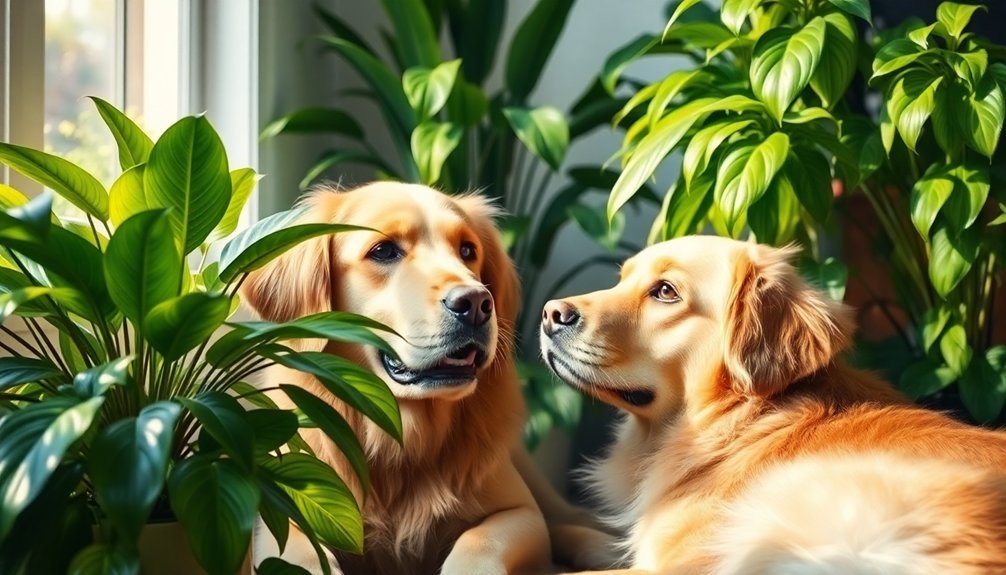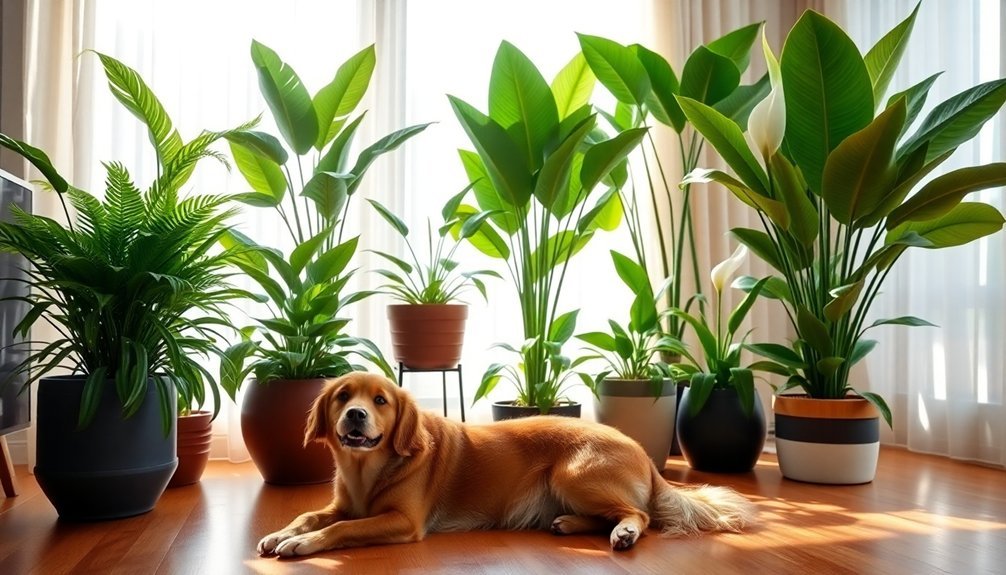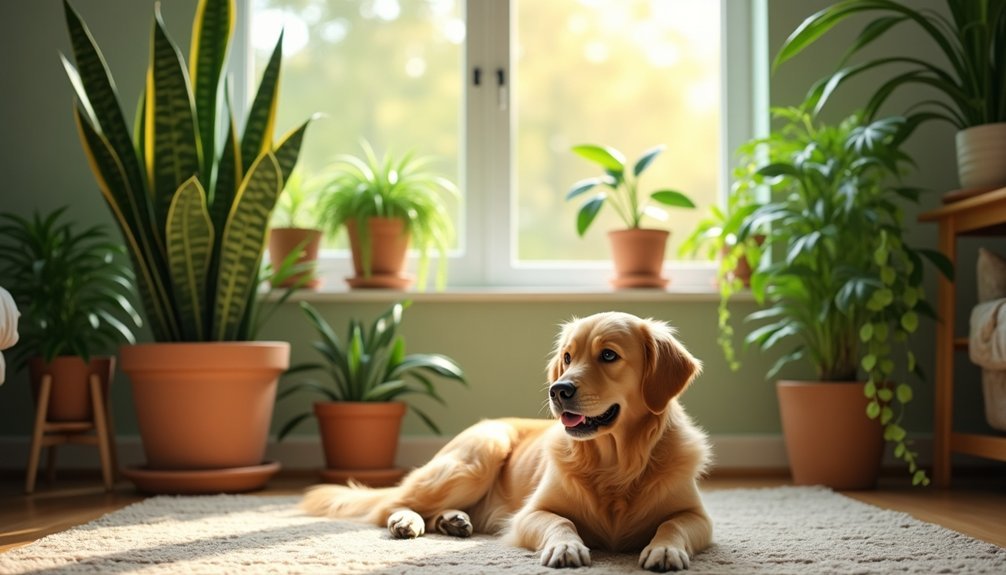You can safely improve your home's air quality with several dog-friendly plants that remove toxins and release fresh oxygen. Spider plants, Boston ferns, and bamboo palms are excellent choices that won't harm your furry friend if nibbled. Place these natural air purifiers in hanging baskets or elevated spots to minimize pet access while maximizing their air-cleaning benefits. Discover how these green companions can transform your space into a healthier environment for both you and your dog.
Why Pet-Safe Air-Purifying Plants Matter

While many pet owners focus on obvious hazards like toxic foods and dangerous toys, the quality of indoor air often goes overlooked.
What you mightn't realize is that your home's air can be as polluted as the most contaminated cities, and your dog spends far more time indoors than you do.
Your furry friend's health depends heavily on the air they breathe. Common household items like cleaning products, furniture, and cooking fumes release volatile organic compounds (VOCs) that can cause your dog to experience burning eyes and breathing difficulties.
Fortunately, through natural photosynthesis, indoor plants convert harmful carbon dioxide into fresh oxygen while filtering out airborne toxins.
That's where pet-safe air-purifying plants come in. However, you'll need to choose carefully – many popular air-cleaning plants are toxic to dogs.
Top Dog-Friendly Plants That Clean Your Air
When you're looking to improve your home's air quality while keeping your furry friends safe, several plants stand out as exceptional choices.
Spider plants, Boston ferns, and bamboo palms top the list as powerful air purifiers that effectively remove toxins like formaldehyde and carbon monoxide while remaining completely non-toxic to dogs.
These easy-care plants not only create a healthier environment but also add natural beauty to your space with their distinctive foliage and growth patterns. If your dog shows interest in the plants, consider elevated placement to maintain both air purification benefits and pet safety.
Best Indoor Air Cleaners
The top four indoor plants that excel at purifying air while being safe for dogs are the Spider Plant, Golden Pothos, Bamboo Palm, and Areca Palm. You'll find these natural air cleaners effectively remove common household toxins while adding beauty to your space. With Americans spending 90% of time indoors, these plants provide essential air-cleaning benefits year-round.
| Plant Name | Key Benefits |
|---|---|
| Spider Plant | Removes formaldehyde, perfect for hanging baskets |
| Golden Pothos | Adaptable to light conditions, removes multiple toxins |
| Bamboo Palm | Adds tropical feel, emits oxygen at night |
| Areca Palm | Pet-safe, eliminates carbon monoxide |
These plants work continuously to purify your indoor air. The Spider Plant thrives in hanging baskets, keeping it safely out of your dog's reach. The Golden Pothos adapts well to various lighting conditions, while both palm varieties add a tropical aesthetic while filtering harmful chemicals from your home's air.
Safe For All Pets
Creating a pet-friendly home doesn't mean sacrificing clean air, as numerous indoor plants can purify your environment while keeping your furry friends safe.
You'll find the Bamboo Palm particularly effective at removing harmful chemicals like benzene and formaldehyde, while being completely safe for your pets to be around.
Consider adding Spider Plants to your collection – they're excellent at filtering out carbon monoxide and other toxins.
If you're dealing with humidity issues, the Boston Fern and Areca Palm work double duty by purifying the air and adding moisture.
For low-light areas, try the Prayer Plant or Money Plant, both of which effectively remove indoor pollutants while requiring minimal maintenance.
Even colorful options like Gerbera Daisies can brighten your space while keeping the air clean and your pets protected.
Signs Your Plant Is Making Your Dog Sick

Recognizing toxic plant symptoms in your dog can mean the difference between a quick recovery and a medical emergency. Pay attention to sudden changes in your pet's behavior or physical condition, as these could indicate plant poisoning.
| Symptom Area | Warning Signs | Severity |
|---|---|---|
| Digestive | Vomiting, diarrhea, loss of appetite | High |
| Behavioral | Depression, lethargy, disinterest | Medium |
| Physical | Drooling, mouth pawing, rashes | High |
| Critical | Seizures, heart changes, tremors | Emergency |
If you notice your dog exhibiting any of these symptoms after being near your houseplants, don't wait – contact your veterinarian immediately. Many plant-related symptoms can escalate quickly, especially those affecting the heart or nervous system. Remove any suspect plants from your dog's reach while seeking medical attention.
Setting Up a Pet-Safe Indoor Garden
When designing a pet-safe indoor garden, you'll need to balance your love for plants with your dog's safety and comfort.
Start by selecting proven pet-friendly options like bamboo palm, spider plant, or Boston fern – all excellent air purifiers that won't harm your furry friend.
Create distinct zones by establishing designated play areas separate from your plants. You'll want to position climbing structures and interactive toys away from your garden space to prevent accidental damage.
Use non-toxic soil and pots, and keep electrical cords tucked away from curious paws.
Don't forget to maintain your garden regularly. Trim overgrown plants, remove fallen leaves, and monitor for signs of pest infestation.
If you're unsure about a plant's safety, consult a veterinarian or gardening expert before adding it to your collection.
Common Toxic Plants to Keep Away From Dogs

While setting up your pet-safe garden is important, knowing which plants to avoid can save your dog's life. Common house plants like sago palm, oleander, and philodendron can cause severe reactions ranging from vomiting to heart failure.
Don't let their beauty fool you – even popular garden favorites like daffodils, azaleas, and Japanese yew can be lethal if ingested.
You'll need to be especially cautious during holidays when decorative plants enter your home. Mistletoe, poinsettias, and eucalyptus might bring festive cheer, but they're dangerous for your dog.
Watch out for ornamental plants too – geraniums, peonies, and hostas contain toxins that can cause serious health issues.
If you're unsure about a plant's safety, it's best to assume it's toxic until you've confirmed otherwise with your veterinarian.
Best Locations for Air-Purifying Plants in Pet Homes
Strategic placement of air-purifying plants can maximize their benefits in your pet-friendly home while keeping your furry friends safe.
Position pet-safe plants near your dog's bed to create a natural, calming environment, but guarantee they're stable and won't tip over during playtime.
You'll want to focus on high-traffic areas where your dog spends most time, as these spots benefit most from air purification.
- Create a peaceful sanctuary by placing Boston Ferns near your pup's favorite napping spot
- Transform your living room into a fresh-air haven with strategically placed Areca Palms
- Design a natural air-filtering system near ventilation points to catch incoming pollutants
Remember to keep plants elevated or in hanging baskets if your dog tends to dig, and always monitor new additions to guarantee they don't cause any behavioral changes in your pet.
Frequently Asked Questions
How Often Should I Prune Air-Purifying Plants to Maintain Their Effectiveness?
You'll need annual hard pruning at the growing season's start, plus regular light pruning throughout the year. Remove dead leaves and spent flowers weekly to maintain air-purifying efficiency and promote healthy growth.
Can Air-Purifying Plants Help Reduce Pet-Related Odors in My Home?
Yes, air-purifying plants can help reduce pet odors in your home by naturally filtering the air, removing VOCs, and promoting fresh air circulation. You'll notice improved air quality and fewer pet-related smells.
Do Pet-Safe Air-Purifying Plants Attract Bugs or Pests?
While pet-safe air-purifying plants can attract pests, you'll avoid most issues by maintaining proper watering, ensuring good ventilation, and regular cleaning. Don't overwater or let humidity build up around your plants.
Which Pet-Friendly Plants Are Best for Apartments With Limited Natural Light?
For your low-light apartment, you'll find spider plants, Boston ferns, and bamboo palms ideal. They're safe for pets, don't need much maintenance, and thrive in dim conditions while helping purify your indoor air.
How Long Do Air-Purifying Plants Typically Live With Proper Care?
You'll find most common air-purifying plants live 5-15 years with proper care. Snake Plants and Spider Plants survive 5-10 years, while Bamboo Palms, Rubber Plants, and Dracaenas can reach 10-15 years.
In Summary
You'll breathe easier knowing your indoor garden is working double-duty: cleaning your air and keeping your pup safe. Remember to monitor your dog's behavior around new plants, position them strategically out of reach, and stick to pet-friendly varieties. With proper setup and plant selection, you can create a fresh, oxygen-rich environment that both you and your four-legged friend will enjoy for years to come.





Leave a Reply